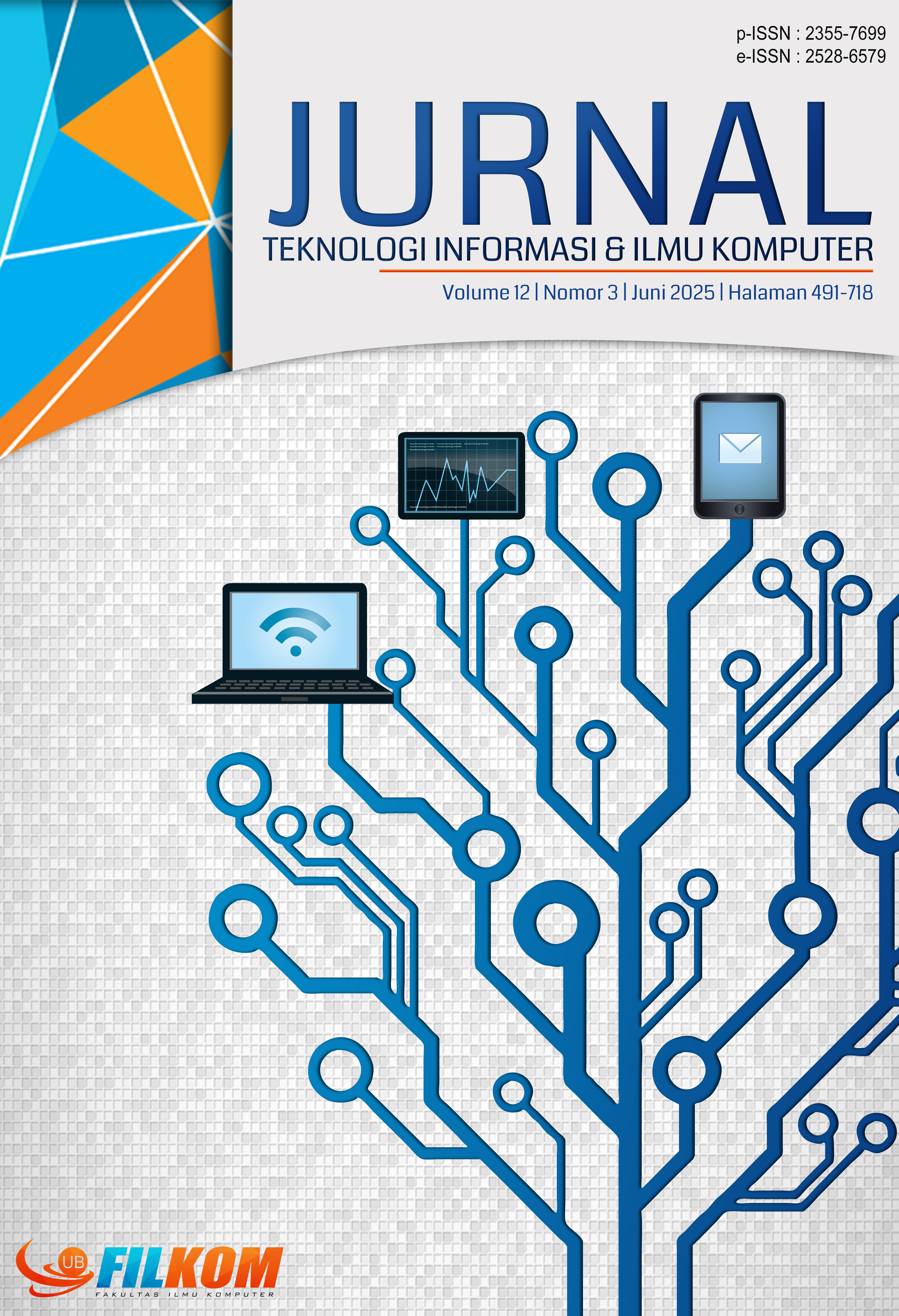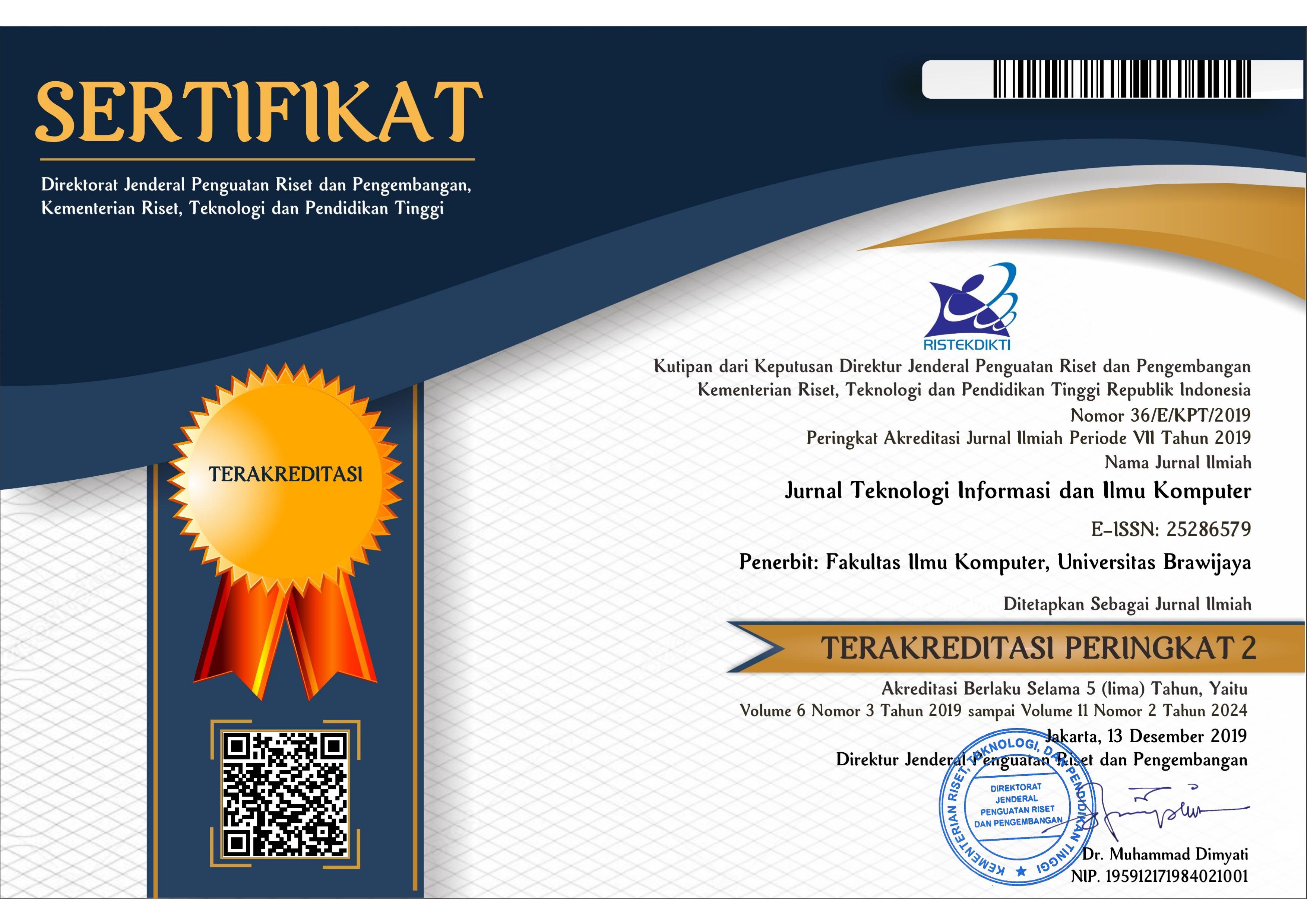Perbandingan Kinerja Arsitektur Convolutional Neural Network Pada Deteksi Malaria Menggunakan Citra Sel Darah
DOI:
https://doi.org/10.25126/jtiik.2025128085Kata Kunci:
citra sel darah, deteksi, kecerdasan buatan, malaria, mobilenetv2Abstrak
Malaria masih menjadi salah satu penyebab kematian tertinggi di dunia, terutama di daerah yang berstatus endemi. Standar emas penegakan diagnosis malaria adalah berbasis citra apusan atau sel darah yang diperoleh dengan menggunakan mikroskop. Kendala utama dalam penegakan diagnosis ini adalah kurangnya tenaga ahli untuk melakukan asesmen citra sel darah. Oleh karena itu, dilakukan diagnosis malaria berbasis citra sel darah menggunakan Artificial Intelligent (AI) / kecerdasan buatan. Deteksi malaria berbasis AI yang dilakukan pada studi-studi sebelumnya telah menghasilkan kinerja yang sudah baik. Namun, kinerja deteksi ini masih dapat ditingkatkan. Studi ini menggunakan 27.558 citra sel darah yang terdiri dari 13.779 sel darah terinfeksi dan 13.779 tidak terinfeksi. Citra-citra sel darah ini dibagi menjadi tiga kelompok, yaitu pelatihan (80%); validasi (10%); dan pengujian (10%). Pada studi ini, digunakan ResNet50; ResNet101; ResNet152; ResNet50V2; ResNet101V2; ResNet152V2; DenseNet121; DenseNet169; DenseNet201; InceptionV3; InceptionResNetV2; VGG16; VGG19; dan MobileNetV2. Tujuan utama dari studi ini adalah mencari arsitektur CNN yang memiliki kinerja terbaik dalam deteksi malaria berbasis citra sel darah. Perbandingan kinerja diases dengan menggunakan nilai akurasi, sensitivitas, spesifisitas, skor F1, dan Area Under the Curve (AUC). Arsitektur MobileNetV2 memberikan kinerja paling baik dengan nilai rata-rata pelatihan, validasi, dan pengujian tertinggi. Nilai rata-rata akurasi mencapai 97,68%; spesifisitas 98,61%; sensitivitas 96,75%; Skor F1 97,70%; dan AUC sebesar 99,65%. Selain itu, waktu pembuatan model arsitektur MobileNetV2 hanya sekitar 2,5 jam. Selain itu, jumlah lapisan convolutional tidak memengaruhi kinerja deteksi malaria. Dengan lapisan convolutional berjumlah 53, MobileNetV2 berkinerja lebih baik dibandingkan dengan arsitektur-arsitektur lain dengan jumlah lapisan convolutional lebih banyak.
Abstract
Malaria is still one of the highest causes of death in the world, especially in the endemic areas. The gold standard for diagnosing malaria is based on smears blood smears or cells image which is obtained using a microscope. The main challenge in detecting malaria is the lack of experts to assess the blood smears. Therefore, the detection is carried out using Artificial Intelligence (AI). Previous studies that used AI to detect malaria have a good performance. However, the detection performance can still be improved. Furthermore, previous studies only used one or two or three performance metrics. This study used 27,558 blood cell images consisting of 13,779 infected and 13,779 uninfected blood cells. These blood cell images are divided into three groups, i.e. training (80%); validation (10%); and testing (10%). In this study, several CNN architectures are used, such as ResNet50; ResNet101; ResNet152; ResNet50V2; ResNet101V2; ResNet152V; DenseNet121; DenseNet169; DenseNet201; InceptionV3; InceptionResNetV2; VGG16: VGG19: and MobileNetV2. The main objective of this study is to find the CNN architecture that has the best performance in blood cell image-based malaria detection. Comparison of performance of CNN architectures are assessed using accuracy, sensitivity, specificity, F1 score, and Area Under the Curve (AUC) values. The MobileNetV2 architecture provides the best performance with the highest average values of training, validation, and testing. The average accuracy value of 97.68%; specificity of 98.61%; sensitivity of 96,75%; F1 Score of 97.70%; and AUC of 0.9965. In addition, the time to build the MobileNetV2 model is about 2.5 hours, the fastest one. This study shows that the number of convolutional layers does not affect malaria detection performance. With 53 convolutional layers, MobileNetV2 has the best performance.
Downloads
Referensi
AKAY, M., DU, Y., SERSHEN, C.L., WU, M., CHEN, T.Y., ASSASSI, S., MOHAN, C. dan AKAY, Y.M., 2021. Deep learning classification of systemic sclerosis skin using the MobileNetV2 model. IEEE Open Journal of Engineering in Medicine and Biology, 2, pp. 104-110.
ASIF, S., KHAN, S.U.R., ZHENG, X. dan ZHAO, M., 2024. MozzieNet: A deep learning approach to efficiently detect malaria parasites in blood smear images. International Journal of Imaging Systems and Technology, 34(1), p.e22953.
BANERJEE, T., JAIN, A., SETHURAMAN, S.C., SATAPATHY, S.C., KARTHIKEYAN, S. dan JUBILSON, A., 2022. Deep Convolutional Neural Network (Falcon) and transfer learning‐based approach to detect malarial parasite. Multimedia Tools and Applications, 81(10), pp.13237-13251.
DEPKES (Departemen Kesehatan Republik Indonesia), 2008. Pedoman penatalaksanaan kasus malaria di Indonesia. Jakarta: Ditjen Pengendalian Penyakit dan Penyehatan Lingkungan.
DEV, A., FOUDA, M.M., KERBY, L. dan FADLULLAH, Z.M., 2023. On improving malaria parasite detection from microscopic images: A comparative analytics of hybrid deep learning models. 2023 11th International Conference on Information and Communication Technology (ICoICT). pp. 417-422. IEEE.
DIKER, A., 2022. An efficient model of residual based convolutional neural network with Bayesian optimization for the classification of malarial cell images. Computers in Biology and Medicine, 148, p.105635.
ELANGOVAN, P. dan NATH, M.K., 2021. A novel shallow convnet-18 for malaria parasite detection in thin blood smear images: Cnn based malaria parasite detection. SN computer science, 2(5), p.380.
ERICKSON, B.J. dan KITAMURA, F., 2021. Magician’s corner: 9. Performance metrics for machine learning models. Radiology: Artificial Intelligence, 3(3), p.e200126.
GJESTEBY, L.A., HABER, E., HAKOZAKI, S., XU, A., DELOSA, N., ROOP, B., WERBLIN, J., TELFER, B. dan BRATTAIN, L.J., 2023. Optimizing MobileNet Algorithms for Real-time Vessel Detection on Smartphones. In 2023 IEEE 19th International Conference on Body Sensor Networks (BSN). pp. 1-4. IEEE.
HUDA, N., DEWI, A.Y. dan MAHIRUNA, A., 2023. Plasmodium falciparum Identification Using Otsu Thresholding Segmentation Method Based on Microscopic Blood Image. Scientific Journal of Informatics, 10(4), pp. 479-488.
KAKKAR, B., GOYAL, M., JOHRI, P. dan KUMAR, Y., 2023. Artificial Intelligence-Based Approaches for Detection and Classification of Different Classes of Malaria Parasites Using Microscopic Images: A Systematic Review. Archives of Computational Methods in Engineering, pp. 1-20.
KHAN, G.Z., SHAH, I.A., HASSAN, M.A., JUNAID, H. dan SARDAR, F., 2023. Intelligent Systems for early malaria disease detection in patient cells using transfer learning approaches. In 2023 4th International Conference on Computing, Mathematics and Engineering Technologies (iCoMET). pp. 1-6. IEEE.
KUMAR, K., CHANDIRAMANI, G. dan KASHYAP, K.L., 2021. Computer-Aided Malaria Detection Based on Computer Vision and Deep Learning Approach. Machine Vision and Augmented Intelligence - Theory and Applications: Select Proceedings of MAI 2021. pp. 541-551. Springer Singapore.
KUMAR, S., VARDHAN, H., PRIYA, S. dan KUMAR, A., 2023. Malaria detection using deep convolution neural network. arXiv preprint arXiv:2303.03397.
KUSUMA, W., LESTARI, A.W., HERAWATI, S. dan YASA, I.W.P.S., 2014. Pemeriksaan Mikroskop Dan Tes Diagnostik Cepat Dalam Menegakkan Diagnosis Malaria. E-Jurnal Medika Udayana, 3(2), pp. 170-186.
KUZHALOLI, S., THENAPPAN, S., PREMAVATHI, T., NIVEDITA, V., MAGESHBABU, M. dan NAVANEETHAN, S., 2023, February. Identification of Malaria Disease Using Machine Learning Models. 2023 Fifth International Conference on Electrical, Computer and Communication Technologies (ICECCT). pp. 1-4. IEEE.
LIU, R., LIU, T., DAN, T., YANG, S., LI, Y., LUO, B., ZHUANG, Y., FAN, X., ZHANG, X., CAI, H. dan TENG, Y., 2023. AIDMAN: An AI-based object detection system for malaria diagnosis from smartphone thin-blood-smear images. Patterns, 4(9).
MAQSOOD, A., FARID, M.S., KHAN, M.H. dan GRZEGORZEK, M., 2021. Deep malaria parasite detection in thin blood smear microscopic images. Applied Sciences, 11(5), p.2284.
MATURANA, C.R., DE OLIVEIRA, A.D., NADAL, S., BILALLI, B., SERRAT, F.Z., SOLEY, M.E., IGUAL, E.S., BOSCH, M., LLUCH, A.V., ABELLÓ, A. dan LÓPEZ-CODINA, D., 2022. Advances and challenges in automated malaria diagnosis using digital microscopy imaging with artificial intelligence tools: A review. Frontiers in microbiology, 13, p.1006659.
MRIDHA, K., TOLA, F.G., SARKAR, S., AREFIN, N., GHIMIRE, S., ARAN, A. dan PANDEY, A.P., 2023, June. Automating Malaria Diagnosis with XAI: Using Deep-Learning Technologies for More Accurate, Efficient, and Transparent Results. In International Conference on Multi-disciplinary Trends in Artificial Intelligence, pp. 297-308. Cham: Springer Nature Switzerland.
MURMU, A. dan KUMAR, P., 2024. DLRFNet: deep learning with random forest network for classification and detection of malaria parasite in blood smear. Multimedia Tools and Applications, pp. 1-23.
NAKASI, R., MWEBAZE, E., ZAWEDDE, A., TUSUBIRA, J., AKERA, B. dan MAIGA, G., 2020. A new approach for microscopic diagnosis of malaria parasites in thick blood smears using pre-trained deep learning models. SN Applied Sciences, 2, pp. 1-7.
NARAYANAN, B.N., ALI, R. dan HARDIE, R.C., 2019, September. Performance analysis of machine learning and deep learning architectures for malaria detection on cell images. In Applications of Machine Learning, 11139, pp. 240-247. SPIE.
OYEWOLA, D.O., DADA, E.G., MISRA, S. dan DAMAŠEVIČIUS, R., 2022. A novel data augmentation convolutional neural network for detecting malaria parasite in blood smear images. Applied Artificial Intelligence, 36(1), p.2033473.
POOSTCHI, M., SILAMUT, K., MAUDE, R.J., JAEGER, S. dan THOMA, G., 2018. Image analysis and machine learning for detecting malaria. Translational Research, 194, pp. 36-55.
RAJARAMAN, S., ANTANI, S.K., POOSTCHI, M., SILAMUT, K., HOSSAIN, M.A., MAUDE, R.J., JAEGER, S. dan THOMA, G.R., 2018. Pre-trained convolutional neural networks as feature extractors toward improved malaria parasite detection in thin blood smear images. PeerJ, 6, p.e4568.
SANDLER, M., HOWARD, A., ZHU, M., ZHMOGINOV, A. dan CHEN, L.C., 2018. Mobilenetv2: Inverted residuals and linear bottlenecks. Proceedings of the IEEE conference on computer vision and pattern recognition. pp. 4510-4520.
SANTOSHI, K., SARANYA, G., REDDY, C.R., REDDY, C.J., GYANANANDU, K. dan TEJ, G.N., 2023, May. Deep Learning based Web App for Malaria Parasite Detection in Granular Blood Samples. In 2023 2nd International Conference on Applied Artificial Intelligence and Computing (ICAAIC). pp. 291-297. IEEE.
SHEKAR, G., REVATHY, S. dan GOUD, E.K., 2020, June. Malaria detection using deep learning. In 2020 4th international conference on trends in electronics and informatics (ICOEI), 48184, pp. 746-750. IEEE.
SINHA, S., SRIVASTAVA, U., DHIMAN, V., AKHILAN, P.S. dan MISHRA, S., 2021. Performance assessment of Deep Learning procedures on Malaria dataset. Journal of Robotics and Control (JRC), 2(1), pp. 12-18.
TELANG, H. dan SONAWANE, K., 2020, October. Effective performance of bins approach for classification of malaria parasite using machine learning. 2020 IEEE 5th International Conference on Computing Communication and Automation (ICCCA), pp. 427-432. IEEE.
TRIFONOVA, O.P., LOKHOV, P.G. dan ARCHAKOV, A.I., 2013. Metabolic profiling of human blood. Biochemistry (Moscow) Supplement Series B: Biomedical Chemistry, 7, pp. 179-186.
VERMA, A., MANSOORI, S., SRIVASTAVA, A., RATHEE, P. dan SINGH, N.P., 2024. Deep learning driven automated malaria parasite detection in thin blood smears. In Artificial Intelligence, Blockchain, Computing and Security, 1, pp. 375-380. CRC Press.
VIJAYALAKSHMI, A., 2020. Deep learning approach to detect malaria from microscopic images. Multimedia Tools and Applications, 79, pp. 15297-15317.
WHO (World Health Organization), 2022. World malaria report 2022. World Health Organization.
WHO (World Health Organization), 2023. Report of the first and second meetings of the technical advisory group on malaria elimination and certification, 13–14 September 2022 and 27 January 2023.
YEBASSE, M., CHEOI, K.J. dan KO, J., 2023. Malaria Disease Cell Classification With Highlighting Small Infected Regions. IEEE Access, 11, pp. 15945-15953.
Unduhan
Diterbitkan
Terbitan
Bagian
Lisensi
Hak Cipta (c) 2025 Jurnal Teknologi Informasi dan Ilmu Komputer

Artikel ini berlisensiCreative Commons Attribution-ShareAlike 4.0 International License.

Artikel ini berlisensi Creative Common Attribution-ShareAlike 4.0 International (CC BY-SA 4.0)
Penulis yang menerbitkan di jurnal ini menyetujui ketentuan berikut:
- Penulis menyimpan hak cipta dan memberikan jurnal hak penerbitan pertama naskah secara simultan dengan lisensi di bawah Creative Common Attribution-ShareAlike 4.0 International (CC BY-SA 4.0) yang mengizinkan orang lain untuk berbagi pekerjaan dengan sebuah pernyataan kepenulisan pekerjaan dan penerbitan awal di jurnal ini.
- Penulis bisa memasukkan ke dalam penyusunan kontraktual tambahan terpisah untuk distribusi non ekslusif versi kaya terbitan jurnal (contoh: mempostingnya ke repositori institusional atau menerbitkannya dalam sebuah buku), dengan pengakuan penerbitan awalnya di jurnal ini.
- Penulis diizinkan dan didorong untuk mem-posting karya mereka online (contoh: di repositori institusional atau di website mereka) sebelum dan selama proses penyerahan, karena dapat mengarahkan ke pertukaran produktif, seperti halnya sitiran yang lebih awal dan lebih hebat dari karya yang diterbitkan. (Lihat Efek Akses Terbuka).















